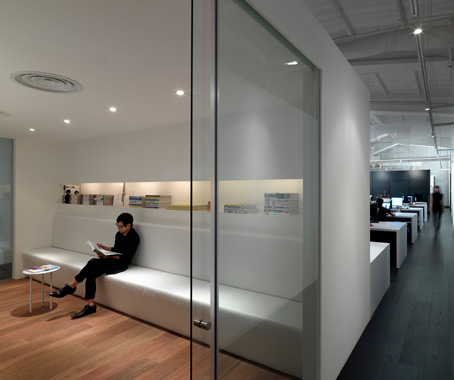We look at Ministry of Design’s inner sanctum through the eyes of its director of design, Colin Seah.

indesignlive.sg
September 13th, 2011
A “truly democratised space” is how Colin Seah describes the creative home of the internationally acclaimed design studio.


Colin Seah, MOD’s director of design
Ministry of Design or MOD now inhabits 6 converted shophouse units at the confluence of Singapore’s historic Chinatown area and the CBD. Importantly, the new studio employs the same key principles that govern the firm’s approach to design – typological relevance, a disciplined material and tonal palette and an ’essentialised’ concept.

While its old office was similarly housed in a heritage building, Seah says MOD’s present location offers greater room for interaction.
“The areas were much more fragmented,” says Seah, recalling MOD’s former studio. “It was a 2-storey space for the old office but we’re all on one floor now. It’s changed the way we work… the team also feels more united and the ties are closer.”

MOD had been determined to find a building large enough to accommodate its entire Singapore workforce of 22 on a single floor – to facilitate open communication and promote a truly open office without hierarchy or barriers, which it believes is essential in fueling innovation and creativity.

The linear series of spaces within the studio are choreographed in between the perimeter of twin datum lines – which form circulation axes spanning the entire space. Mirrored terminus points elongate these axes and become daily ’catwalks’. Resembling a barcode, a series of mixed program are positioned along these catwalks and range from a gallery space to meeting areas, open plan desks, hot desk discussion zones and a library.

All new interventions are conceived as objects within the landscape of the existing space and are designed to remain visually separated. Case in point: the gallery allows for constant renewal and serves as an avenue for MOD to express itself without needing to reinvent the entire studio.


“Apart from addressing the functions (public, like meeting rooms and a gallery versus private, like the work desks and library, etc) the environment needed to be simultaneously distinct yet neutral,” says Seah.
Having a neutral canvas was fundamentally important. “We could not have an environment that was overly designed so much that it would tone our thinking in a subconscious way,” he says.
“It’s exactly what we were looking for… the team loves it, we get to see what each other is doing and the energy is shared.”
Ministry of Design
modonline.com
A searchable and comprehensive guide for specifying leading products and their suppliers
Keep up to date with the latest and greatest from our industry BFF's!

Sub-Zero and Wolf’s prestigious Kitchen Design Contest (KDC) has celebrated the very best in kitchen innovation and aesthetics for three decades now. Recognising premier kitchen design professionals from around the globe, the KDC facilitates innovation, style and functionality that pushes boundaries.

In the pursuit of an uplifting synergy between the inner world and the surrounding environment, internationally acclaimed Interior Architect and Designer Lorena Gaxiola transform the vibration of the auspicious number ‘8’ into mesmerising artistry alongside the Feltex design team, brought to you by GH Commercial.

Create a configuration to suit your needs with this curved collection.

Channelling the enchanting ambience of the Caffè Greco in Rome, Budapest’s historic Gerbeaud, and Grossi Florentino in Melbourne, Ross Didier’s new collection evokes the designer’s affinity for café experience, while delivering refined seating for contemporary hospitality interiors.

German brand Aeris have created an office chair that presents a new perspective in seating.
HP&G combine with Corina Baldwin to bring back tradition at this year’s Melbourne Cup.
The internet never sleeps! Here's the stuff you might have missed

Welcome to the year of the Design Effect. This year’s theme aims to showcase the profound ripple effects that exceptional design can have on people, place and planet. Join in shaping this narrative by contributing your perspective before May 3, 2024, and become a part of the Design Effect movement.

Boasting unmatched cooking and food preservation capabilities, Sub-Zero and Wolf enable designers to set a new standard for kitchen design, and inspire a higher quality of culinary experience.